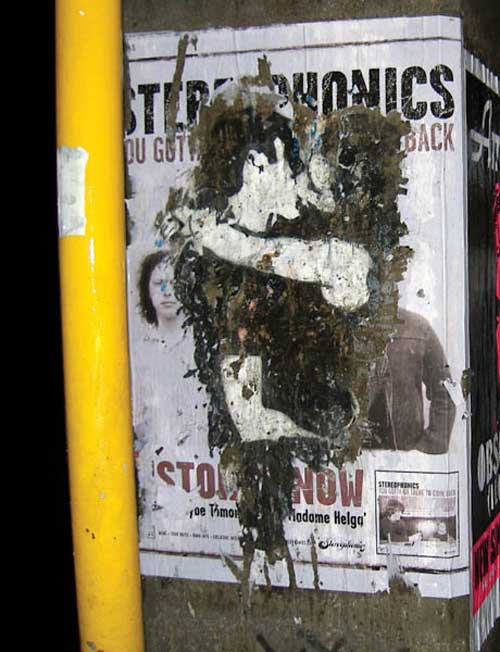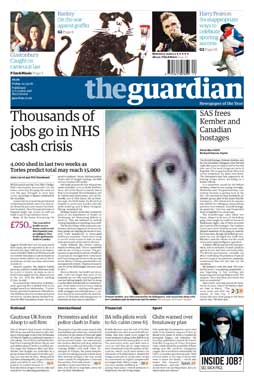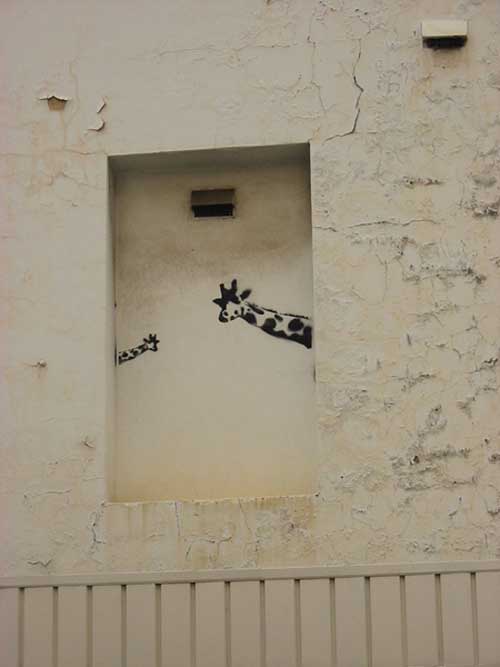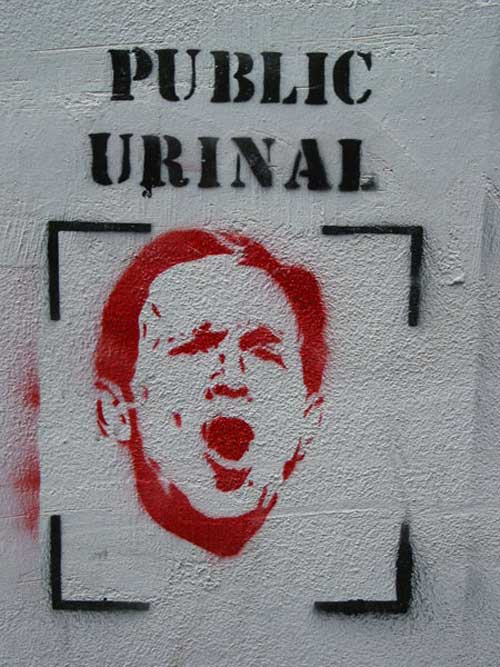- March 24, 2006
- Posted by Marc
Banksy Takes on The Melbourne Street Art Scene In Today’s Guardian

Kiss by Sixten
 Over the last week or so, Banksy has been writing an article for The Guardian newspaper. The subject: the changing street art scene in Melbourne leading up to the Commonwealth games. The piece came out today and is featured on the front cover of the paper. Amongst some of the people Banksy spoke with for the article include our good friend Professor Allison Young. Nice one B!
Over the last week or so, Banksy has been writing an article for The Guardian newspaper. The subject: the changing street art scene in Melbourne leading up to the Commonwealth games. The piece came out today and is featured on the front cover of the paper. Amongst some of the people Banksy spoke with for the article include our good friend Professor Allison Young. Nice one B!
Here’s the piece in it’s entirety.
The Writing On The Wall
The biggest loser of the Commonwealth games, says graffiti artist Banksy, is Melbourne’s street art scene - and London could be next for the whitewash
Friday March 24, 2006
The Guardian
Melbourne is the proud capital of street painting with stencils. Its large, colonial-era walls and labyrinth of back alleys drip with graffiti that is more diverse and original than any other city in the world. Well, that was until a few weeks ago, when preparations for the Commonwealth games brought a tidal wave of grey paint, obliterating years of unique and vibrant culture overnight.
This may seem like no great tragedy to readers of the Daily Mail, but Melbourne’s graffiti scene is a key factor in its status as the continent’s hothouse of creativity and wilful individualism.
Melbourne became a hub of stencilling for reasons no one seems particularly able to explain. Its laid-back atmosphere and sense of isolation most probably have something to do with it. Painters there have never been as shackled to the New York school of large letters on subway trains that took a stranglehold everywhere else. Rather than scrawling their name across a window, most preferred to paint something a little different: a dog chasing a butterfly on a mailbox, for instance, or a couple kissing in the space left where an old poster has been ripped away.
Witty, playful, often angry, the free rein taken by Melbourne’s street artists became about much more than just daubing on a wall. It has drawn in generations of artists, thinkers and tourists to explore and experiment in the city. It gave fresh life to the worlds of fashion and music and is arguably Australia’s most significant contribution to the arts since they stole all the Aborigines’ pencils.
“The Melbourne scene is incredibly diverse,” says Alison Young, head of the department of criminology at Melbourne University. “The range of artists includes people in their 40s, in their teens and a relatively large number of women.” Young was commissioned by the city council to draw up a draft graffiti strategy last March in which she recommended tolerance zones be set up where street art and graffiti be allowed a small space within the city, where writers and artists would be at a lower risk of being arrested. “This was rejected by the city council, despite it generating lots of public support and despite evidence being presented that zero tolerance, for lots of reasons, wouldn’t work.”
Instead, the council doubled its anti-graffiti budget. “The clean-up is an imposition of a supposedly mainstream, or dominant, cultural view,” says Young, “in denial of the diversity of cultural styles that actually exist within a city space.”
What is disappointing about the authority’s attitude is that Australia is probably still the only country in the world to have elevated a graffiti writer to the status of national public hero. Arthur Stace was an alcoholic from the slums of Sydney who found God while listening to a Baptist preacher in a hostel in the 1940s and took to writing the word “eternity” on the ground in chalk. He rendered it in meticulous copperplate script more than half a million times across Sydney over the next three decades, becoming an urban legend before his death in 1967 at the age of 83. He has since been honoured by a plaque, a range of council-approved merchandise and was the centrepiece of celebrations when the word “eternity” in his trademark hand was lit up in 100ft-high letters on Sydney harbour bridge to mark the new millennium.
Then came the Commonwealth games and a redoubling of the city’s efforts to rid itself of the evil graffiti menace. “Cleaning crews have been at work all along the main railway line that runs from the centre of the city to the main sporting venue for the games, destroying miles of continuous artwork,” says Jake Smallman, who has edited a recent book called Stencil Graffiti Capital: Melbourne, compiling some of the city’s more inventive street art. In February, police were rumoured to have infiltrated an exhibition showcasing photographs from the book as part of an intelligence-gathering exercise. “Graffiti’s not art,” said the police minister Tim Holding, in response to the book. “It’s vandalism and it’s something we all deplore.”
Melbourne’s innovative painting scene has been a key player in the global development of street art in recent years. Rather bizarrely for an art form that requires a casual interpretation of the law, graffiti has been steeped in rules and conservatism ever since Taki 183 picked up a can of Krylon spray paint in New York in the 1970s. A strict code was soon established that decreed what a piece should consist of and how many you needed to paint to achieve a certain status. It is only since the omnipresence of tags (graffiti signatures) has turned them into a kind of forgettable urban wallpaper that the art form has started to evolve again. Modern street art is the product of a generation tired of growing up with a relentless barrage of logos and images being thrown at their head every day, and much of it is an attempt to pick up these visual rocks and throw them back.
The street art destroyed in Melbourne will survive on graffiti’s new best friend - the internet. The web has done wonders for graffiti; it perfectly reflects its transient nature, and graffiti is ludicrously overrepresented on its pages. The ability to photograph a street piece that may last for only a few days and bounce it round the world to an audience of millions has dramatically improved its currency. On the other hand, the internet is turning graffiti into an increasingly virtual pastime. It is now possible to achieve notoriety by painting elaborate pieces in secluded locations, without the associated risk of arrest that is usually attached. By posting photographs online you can become a significant graffiti writer from a town where none of your work is actually visible.
The precedent set by Melbourne does not bode well for London in the build-up to the 2012 Olympics. The games will be set in east London, where Hackney is one of the few remaining parts of the city where affordable studio space for artists still exists. After the warehouses have been flattened by compulsory purchase orders, the pots of grey paint will be opened and an area rich in street culture and frontier spirit will disappear. Factory doors whose flaked layers of Hammerite reveal history like the rings in a tree stump will be thrown on the fire. Disused cranes perched on top of foundries like skeletal crows will be torn down. Everything will be replaced by a cardboard-partitioned village perched on a pile of cheap laminate flooring. And if you think the graffiti will be removed so it can be replaced by vistas of clean urban space, think again. Every meaningful spot will be clogged with giant billboards by the likes of McDonald’s encouraging you to get fit by staying at home and watching the games on TV.
This is not to say that every city should aim to look like the south Bronx, or that regeneration cannot be a good thing, but society’s headlong march into bland conformity should not necessarily be welcomed with such open arms. In the 1990s, large sections of football grounds were demolished to make way for executive boxes - only then did people start to complain about the lack of atmosphere.
Melbourne and London are genuine epicentres of the skewed human touch that can bring a little sparkle into the drudgery of public space. A feat that is of immense value, despite its apparent worthlessness. And a feat that is not so easily achieved by trying to run around a track in under four minutes.

Giraffe by Prism

